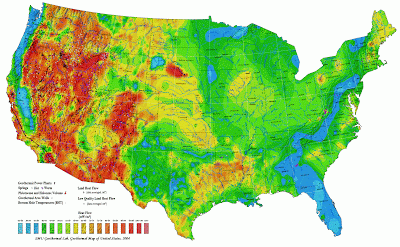When it comes down to renewable energy, most people think only of wind turbines, and solar panels, because most people think how solar and wind power are the two only renewable energy sources. But this is far from truth, there is also geothermal energy that can be quite useful energy source but many people know very little about this energy source. Maybe this has to do with the fact that oil companies want us to think of solar and wind power as the only renewable energy sources, because solar and wind power doesn’t directly affect oil and propane use.
The golden “oil age” is far behind, going down to a strong political campaign that brought geothermal, a very important renewable energy source, well up front. The new administration gave its full blessing to geothermal energy in form of substantial tax credits enabling just about everyone to take advantage of geothermal energy.
There are some already claiming how geothermal energy should be the first choice to reduce nation's dependence on fossil fuel. But how can the average home save a significant amount of money every year by replacing fossil fuel with geothermal? Well you are probably already familiar with fluctuations in fuel prices that have potential to go out of control in the matter of days. The cost of heating homes is no longer negligible and has become an expensive proposition, despite today’s "seemingly low" fossil fuel prices. It is really only matter of time before fossil fuel prices will go up, reaching very high levels. Just to remind you in July 2008, the price of oil doubled in less than 30 days. Who can guarantee us that this scenario won't happen once again?
Geothermal energy can provide not only 100 percent of home heating, but also air conditioning and hot water, and it require no additional use of oil, natural gas or any other fossil fuel. And the payback on geothermal is more than acceptable. If you consider the 30 percent federal tax credit, payback usually takes less than five years in new construction and somewhere around seven years for retrofits. This translates to gigantic 15 percent annual return on investment simply by installing a geothermal system, which is really a number from which many other energy sources are still far off. The logic in this whole story is quite simple, namely homeowners pay back the investment with the money they would have paid to oil or gas company. After payback, the savings continue with an average return of more than 65 percent – percentage that is likely to be even higher as fossil fuel prices are very likely to increase after recession is over.
And geothermal can be retrofitted into most existing structures. According to the U.S. Department of Energy, geothermal heat pumps are far more efficient and reliable than any fossil fuel furnace or boiler so it is really no surprise that hundreds of homes throughout the Catskills and Hudson Valley are now getting all their heating, cooling and hot water from geothermal energy. The other huge benefit is that geothermal energy can be easily adapted into most existing structures.
How to calculate cost of geothermal system needed for your household? Cost to professionally install a geothermal system is computed based on total heating load required by the specific needs of your home. Professional geothermal installers, even before sizing a system, will recommend ways to reduce energy use. For an average 3,000-square foot Colonial, that’s five years old, geothermal air heating and cooling with appropriate energy efficiency measures would cost under $38,000 and provide all heating, cooling and hot water needs. With tax credits, the out-of-pocket costs are about $26,000. This is really a bargain price when you look at the all advantages.


1 comment:
The theory and design of home geothermal energy systems is sound. The problem is with the human infrastructure.
Here is Colorado, I installed a geothermal heat and hot water assist system. The design was sound, but the designer I hired (with good references) subcontracted installation work to an inexperienced, incompetent plumber. Numerous errors led to a non-functioning, expensive, problematic system.
The one-person design company I originally hired kept bringing back the incompetent plumber to try to fix his own screw-ups, because the designer could get him to return cheaply.
The problems continued until I went to a more reliable, albeit expensive, heating contractor with geo experience. At this point the designer bailed on standing behind his system or covering the repair costs. The problems are slowly being fixed and we've enjoyed good, inexpensive geothermal heat throughout most of this winter, although I've given up on the de-superheater hot water part. That part of the system keeps breaking down or shorting out, and the manufacturer refuses to deal directly with residential customers.
My advice is to wait awhile until the industry shakes out a bit more. There will be spotty manufacturer customer service and unreliable start-ups that go in and out of the residential geothermal business who won't stand behind their work for the long haul.
Post a Comment